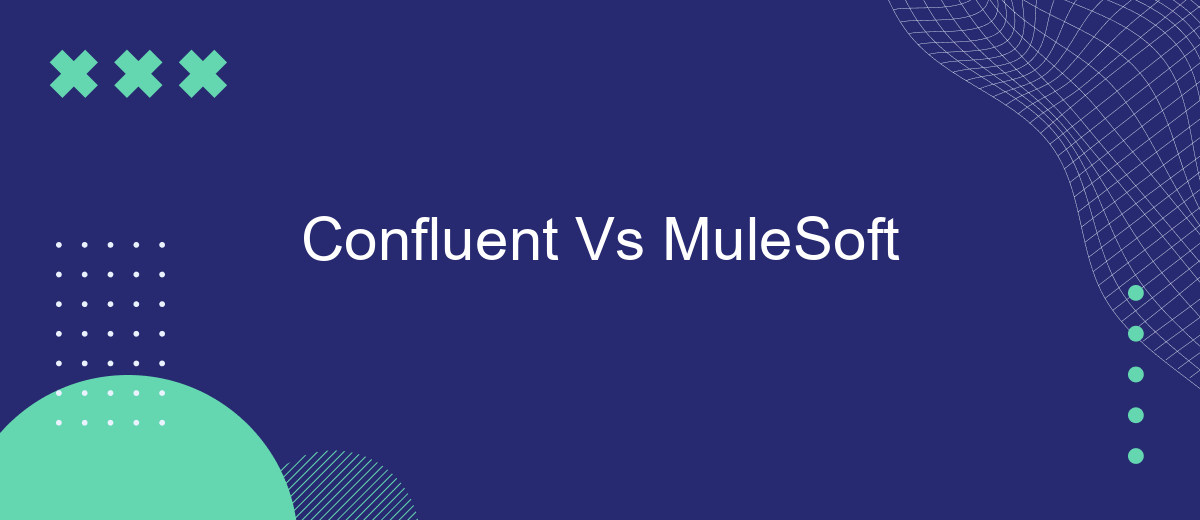In today's rapidly evolving digital landscape, businesses are increasingly relying on robust integration platforms to streamline their operations and enhance data flow. Two leading contenders in this space are Confluent and MuleSoft. This article delves into a comprehensive comparison between Confluent, known for its real-time data streaming capabilities, and MuleSoft, renowned for its versatile integration solutions, to help you determine which platform best suits your business needs.
Introduction
In the ever-evolving landscape of enterprise technology, integration platforms play a crucial role in ensuring seamless connectivity between various systems and applications. Confluent and MuleSoft are two leading solutions in this domain, each offering unique capabilities to address diverse integration needs. Understanding the differences and advantages of these platforms can help businesses make informed decisions about their integration strategies.
- Confluent: Specializes in real-time data streaming and event-driven architecture, primarily built on Apache Kafka.
- MuleSoft: Known for its comprehensive API-led connectivity approach, enabling robust and scalable integrations across a wide array of applications and services.
- SaveMyLeads: A user-friendly service that automates lead generation and data integration, simplifying the process of connecting various marketing and sales tools.
Choosing between Confluent and MuleSoft depends on specific business requirements, such as the need for real-time data processing or extensive API management. Additionally, complementary tools like SaveMyLeads can further enhance integration efforts by automating data flows and ensuring that all systems work harmoniously. This comparison aims to provide a clearer understanding of how each platform can meet distinct integration challenges.
Capabilities Matrix

When comparing Confluent and MuleSoft, it is essential to understand the capabilities each platform brings to the table. Confluent, built on Apache Kafka, excels in real-time data streaming and event-driven architecture, enabling seamless data flow across various systems. It provides robust tools for data integration, stream processing, and real-time analytics, making it ideal for organizations that require high-throughput and low-latency data processing. MuleSoft, on the other hand, specializes in API-led connectivity, offering a comprehensive suite of tools for building, managing, and monitoring APIs. This allows businesses to connect applications, data, and devices effectively, promoting agility and scalability in their integration strategies.
In addition to these core capabilities, both platforms support various integration tools and services. For instance, SaveMyLeads can be a valuable addition to an integration strategy, providing an easy-to-use interface for automating lead data transfers between different platforms. This service can complement MuleSoft's API management and Confluent's data streaming capabilities by ensuring that lead data is efficiently and accurately moved across systems, enhancing overall operational efficiency. By leveraging these platforms and services, organizations can create a more connected and data-driven environment.
Key Differences

When comparing Confluent and MuleSoft, it's essential to understand their key differences to determine which platform best suits your business needs. Both platforms offer robust integration solutions but cater to different aspects of data management and integration.
- Core Functionality: Confluent is primarily focused on real-time data streaming and event-driven architecture, leveraging Apache Kafka. MuleSoft, on the other hand, specializes in API-led connectivity and integration, enabling seamless data flow across various applications and systems.
- Use Cases: Confluent is ideal for scenarios requiring high-throughput data processing and real-time analytics, such as financial transactions and IoT data streams. MuleSoft excels in enterprise application integration, API management, and creating a unified data ecosystem.
- Integration Capabilities: While Confluent integrates well with data lakes, warehouses, and real-time applications, MuleSoft offers extensive pre-built connectors and templates for various enterprise applications, enhancing its integration capabilities. Tools like SaveMyLeads can further simplify the process of connecting and automating workflows across different platforms.
In summary, Confluent is best suited for real-time data streaming and analytics, whereas MuleSoft provides comprehensive solutions for API management and enterprise integration. The choice between the two depends on your specific requirements and the nature of your data integration needs.
Choosing the Right Tool

When it comes to choosing between Confluent and MuleSoft, it's essential to consider your specific integration needs and business goals. Both platforms offer robust solutions, but they cater to different use cases and technical requirements.
Confluent is ideal for real-time data streaming and event-driven architectures. It leverages Apache Kafka to provide a scalable and reliable platform for data integration. On the other hand, MuleSoft excels in API-led connectivity, enabling seamless integration of various applications and services through its Anypoint Platform.
- If you need real-time data processing and event streaming, Confluent is the go-to choice.
- For a comprehensive API management solution, MuleSoft is more suitable.
- Consider the complexity of your integration landscape and the skill set of your team.
- Evaluate the total cost of ownership, including licensing, maintenance, and support.
Additionally, tools like SaveMyLeads can simplify the integration process by automating workflows and connecting various services without extensive coding. This can be particularly beneficial for businesses looking to streamline their operations with minimal technical overhead. Ultimately, the right choice depends on your specific requirements and long-term strategic goals.
Conclusion
In conclusion, both Confluent and MuleSoft offer robust solutions for integration and data management. Confluent excels in real-time data streaming and event-driven architectures, making it ideal for organizations that require immediate data processing and analytics. On the other hand, MuleSoft provides a comprehensive platform for API-led connectivity, enabling seamless integration across various systems and applications. Each platform has its unique strengths, and the choice between them should be guided by specific business needs and technical requirements.
Additionally, services like SaveMyLeads can further enhance integration processes by automating data transfers between different platforms without the need for extensive coding. This can save time and reduce the complexity of managing multiple integrations, allowing businesses to focus on their core activities. Ultimately, the best solution will depend on the specific use case, but leveraging tools like SaveMyLeads can provide significant value in streamlining integration efforts.
FAQ
What are the primary differences between Confluent and MuleSoft?
Can Confluent and MuleSoft be used together?
Which platform is better for real-time data processing?
Is it possible to automate data flows between Confluent and MuleSoft?
What are the deployment options for Confluent and MuleSoft?
Don't waste another minute manually transferring leads from Facebook to other systems. SaveMyLeads is a simple and effective tool that will allow you to automate this process so that you don't have to spend time on the routine. Try SaveMyLeads features, make sure that this tool will relieve your employees and after 5 minutes of settings your business will start working faster.
